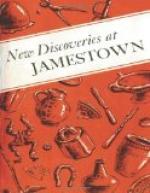Wells
At Jamestown, wells are conspicuous features near many house locations. Those that have been found may be summarized as follows: wood lined—1; circular, brick cased—10; circular, uncased with wooden barrel at bottom—6; circular, uncased, incompletely excavated—4.
Wells are invariably found filled with earth mixed with trash, mainly food animal bones. A well, located immediately north of the row house, had a human left leg and left half of the pelvis buried in the fill at a depth of 4 feet.
Ditches
The most significant feature determining landholdings are the ditches of the Jamestown area. During the 1954-56 explorations 63 ditches were added to the 33 previously discovered, thus increasing the opportunity to delineate property lines, many of which used to be bounded by such ditches.
[Illustration: Careful excavation was required to identify the fill of long-obliterated ditches once draining fields and marking property boundaries.]
Refuse Pits
“James Citty,” like all other settlements in all ages, had to have places for disposal of refuse. That much refuse was disposed of by casting it in the James River is unlikely, since before the dawn of history it has been a trait of man to live on top of his own refuse rather than litter a shore with it. While it may be that no pits were dug purposely for refuse disposal, pits opened for brick or ceramic clay (or dug for ice houses, wells, or other purposes and later abandoned) were used for dumping trash. In 1955 a refuse pit almost 40 feet square was discovered in the “industrial area” near the workshop, ironworking pit, and pottery kilns. Filled with trash from the first half of the 17th century, this pit contained such artifacts as a swepthilt rapier (made about 1600), a cutlass, the breastplate and backpiece of a light suit of armor, a number of utensils of metal, ceramics, and glass, to add to the collection of early 17th-century arts and crafts. Several smaller refuse pits were noted, and it is worth commenting that many ditches finally became trash accumulation areas.
[Illustration: A cutlass in excellent preservation and many other objects from 17th-century Jamestown were found in A large clay Borrow pit filled with refuse.]
Roads
Only one road identified by 17th-century references has been definitely located by archeologists. This is the “Maine Cart Road,” sometimes called the “Greate Road,” leading from Glasshouse Point across the isthmus and onto the island, where it can be traced as far as its passage into the main “James Citty” area just north of the brick church and churchyard. A trace is all that remains of a road which once ran east-west between parallel ditches, south of the row house.




